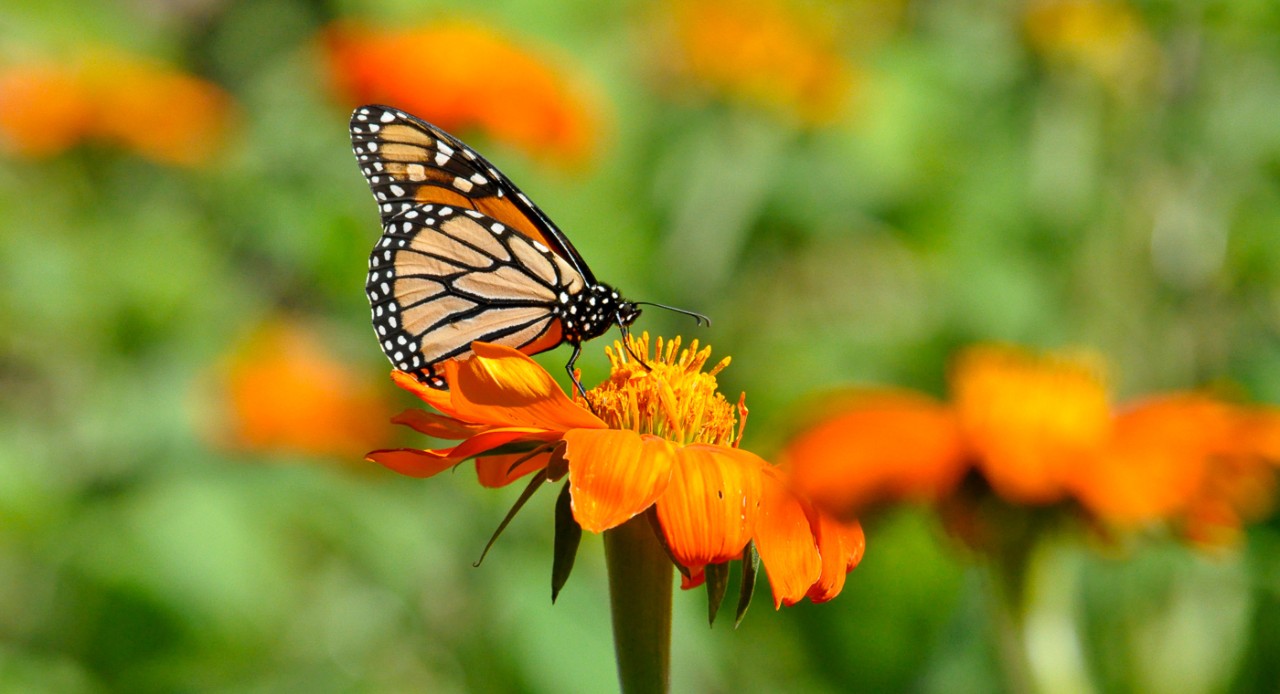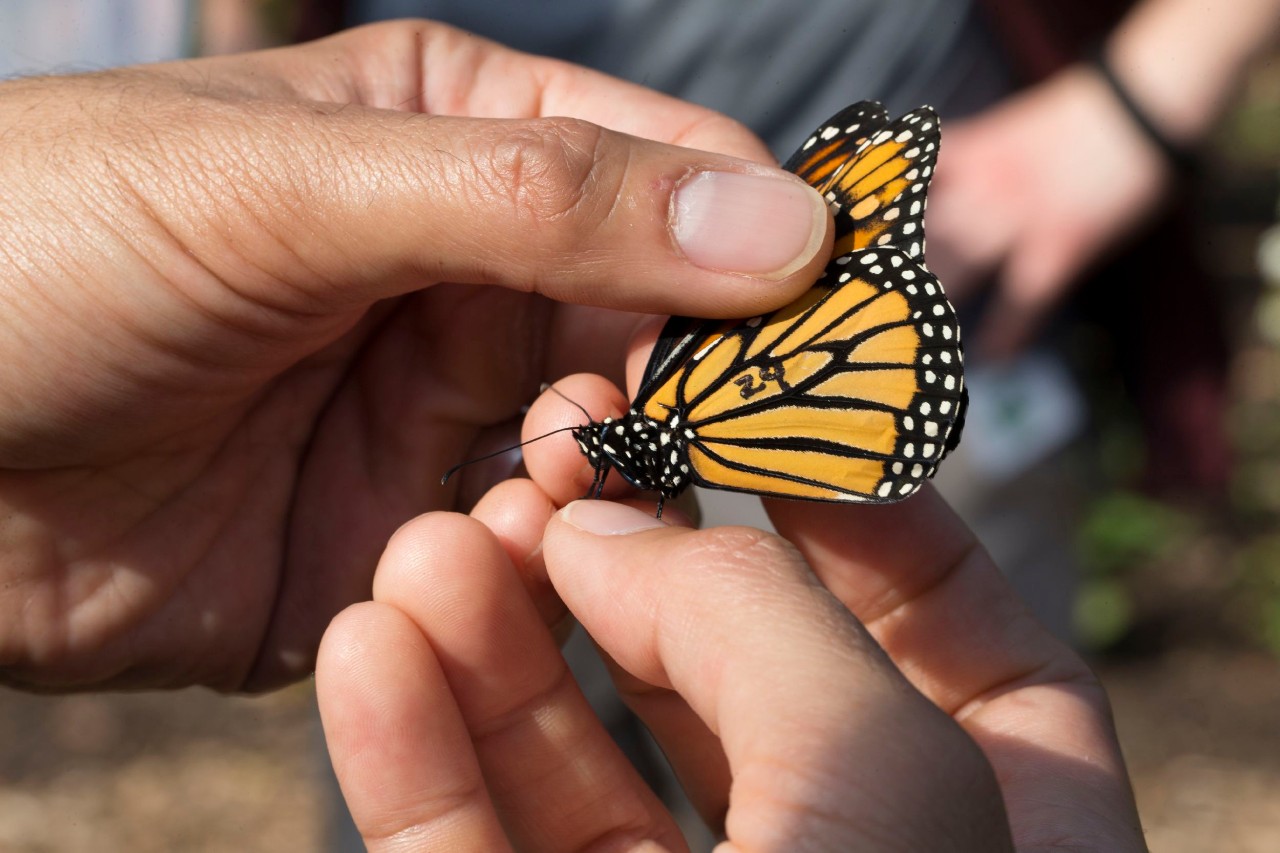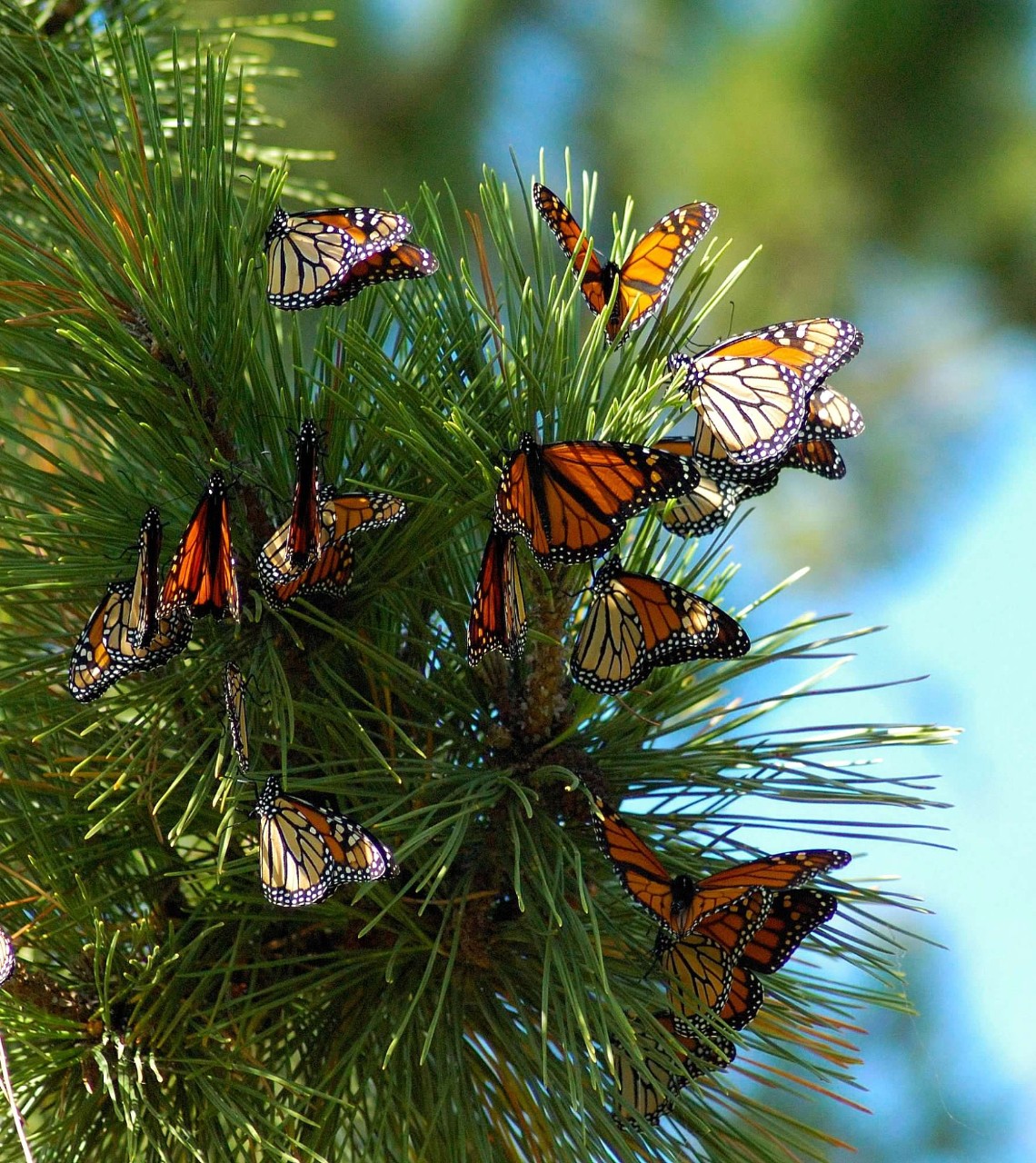
Light pollution can disorient monarch butterflies
Even a single nearby light can throw off the butterfly’s internal compass, UC biologists say
Besides planting milkweed in the garden, people interested in helping monarch butterflies might want to turn off the porch light.
Biologists at the University of Cincinnati say nighttime light pollution can interfere with the remarkable navigational abilities of monarchs, which travel as far as Canada to Mexico and back during their multi-generational migration.
Researchers found that butterflies roosting at night near artificial illumination such as a porch or streetlight can become disoriented the next day because the light interferes with their circadian rhythms. Artificial light can impede the molecular processes responsible for the butterfly’s remarkable navigational ability and trigger the butterfly to take wing when it should be resting.
“We found that even with a single work light that you find at a construction site, monarch butterflies treat that like it’s the sun,” UC assistant professor Patrick Guerra said.
The study was published in the journal iScience.

UC assistant professor Patrick Guerra studies the amazing navigation of monarch butterflies. Photo/Lisa Ventre/UC Creative + Brand
With their erratic, circuitous movements taking them to and fro across your garden, it might be hard to imagine monarch butterflies sticking to a rigid flight plan. But their migrations take some monarch populations thousands of miles to the same forests in Mexico where they spend the winter.
Monarchs are not unique in their multigenerational migrations, co-author and UC master’s graduate Samuel Stratton said. He is pursuing a doctorate at the University of Michigan.

UC biology students are unlocking the secrets of the monarch butterfly's epic migration across North America. Photo/Lisa Ventre/UC Creative + Brand
“Multigenerational migration is a common system in insects. It’s a fairly common but less observed phenomenon,” he said.
For example, the painted lady butterfly can take six generations to travel 9,000 miles (or 14,484 kilometers) from Africa to the Arctic Circle and back. The green darner dragonfly takes three generations to migrate from midwestern and northern states to southern states where their grandchildren overwinter.
Now researchers want to know whether light pollution is impeding this amazing cross-country trek in monarchs.
“It's an important question given that many migrants fly through urban areas,” Stratton said. “Getting some ecological data would be really helpful to seeing what impacts light pollution can have on orientation and migratory outcomes.”

UC assistant professor Patrick Guerra, left, talks to Cincinnati Zoo & Botanical Garden exhibit manager Lyn Lutz about his students' butterfly project in the zoo's pollinator garden. Photo/Lisa Ventre/UC Creative + Brand
Monarchs rely on the darkness of night to process proteins key to their internal compass. These help the insects tell which direction to fly to reach their southern wintering grounds and return.
“The animal keeps track of day and night from this molecular system of production and degradation of proteins,” Guerra said.

Samuel Stratton. Photo/Dale Austin/University of Michigan
Light pollution can disrupt normal circadian rhythms and sleep-wake cycles of wildlife and people alike. City lights have been shown to disrupt the navigation of animals like baby sea turtles, which mistake them for the glow of the moon on the ocean and head away from the water when they hatch.
Adam Parlin, the study's lead author, said nighttime light pollution could affect people and wildlife in surprising ways.
“Nighttime light pollution has been on the radar for some time, but it is a big environmental problem,” said Parlin, a former UC postdoctoral researcher who now teaches at SUNY-ESF.
“When we consider the concept of ‘one health,’ looking at human, wildlife and environmental health together, we can see how organisms are being adversely affected by nighttime light pollution,” Parlin said.
Researchers have examined the effects of light pollution on birds and other animals that migrate at night.
“We wanted to focus on animals that migrate during the day,” Guerra said.
Millions of monarch butterflies living east of the Rocky Mountains leave their summer breeding grounds in southern Canada and the northern United States, traveling as much as 2,500 miles (or 4,000 kilometers) to overwintering sites in Mexico.
Monarchs can take up to five generations during this cross-continent trek and back. Along the way, they use an internal clock that tells them where to orient themselves in relation to the changing position of the sun in the sky.
It's like jet lag. Essentially, their sense of time is disturbed.
Patrick Guerra, UC biologist
But monarchs exposed to nighttime light pollution, like a street lamp above their chosen roost in a cedar tree, can experience a phase shift, making their body think it’s either earlier or later than it really is. That can throw off their sense of time, UC researchers found.
“It’s like jet lag,” Guerra said. “Essentially, their sense of time is disturbed.”
UC researchers demonstrated this effect by conducting controlled laboratory studies. They simulated and isolated the effects of light trespass perturbation on migratory animals normally active in the day.
“We found that you’re messing with their day-night cycle. Light pollution can make them think that the day is longer or that the day starts sooner,” he said.
So if you want to be hospitable to monarchs, Guerra said, maybe don’t keep the light on for them.
“It’s something to think about if you’re making a pollinator garden or if you want to be eco-friendly,” Guerra said.
Featured image at top: UC researchers found that artificial light can throw off the navigation of monarch butterflies. Photo/Michael Miller

Monarch butterflies often roost together when the temperatures dip at night during their migration. UC researchers found the butterflies are sensitive to bright lights when they're resting at night. Photo/Michael Miller
Impact Lives Here
The University of Cincinnati is leading public urban universities into a new era of innovation and impact. Our faculty, staff and students are saving lives, changing outcomes and bending the future in our city's direction. Next Lives Here.
Related Stories
Cold-blooded and they make great friends
March 11, 2025
First-year student Josh Lantz starts a Herpetology Club at the University of Cincinnati.
REVIEW: CCM's 'A Midsummer Night's Dream' an 'exuberant triumph
March 10, 2025
The Cincinnati Business Courier praises UC College-Conservatory of Music's production of A Midsummer Night's Dream. Presented as part of the Opera Series on March 6-9, the production was directed by Robin Guarino and conducted by alumni guest artist William Langley.
Study: Long sentences for juveniles make reentry into society...
March 10, 2025
University of Cincinnati criminologist J.Z. Bennett has a new study that appears in the journal Criminology. The study, "Thicker Than Blood: Exploring the Importance of Carceral Bonds for Those Formerly Serving Juvenile Life Without Parole Sentences," examines the societal barriers to reentry for juveniles who served long prison sentences.
